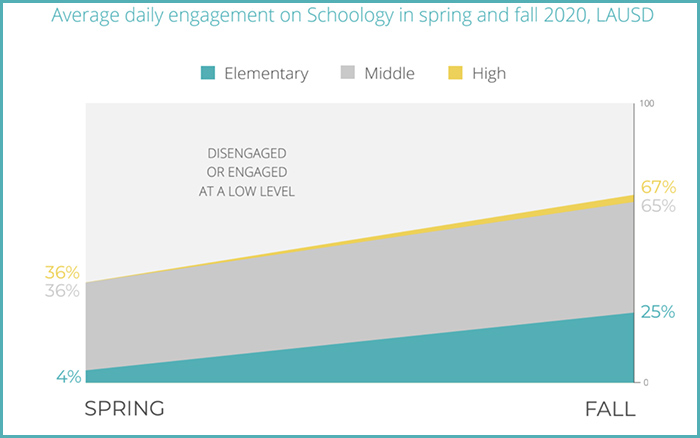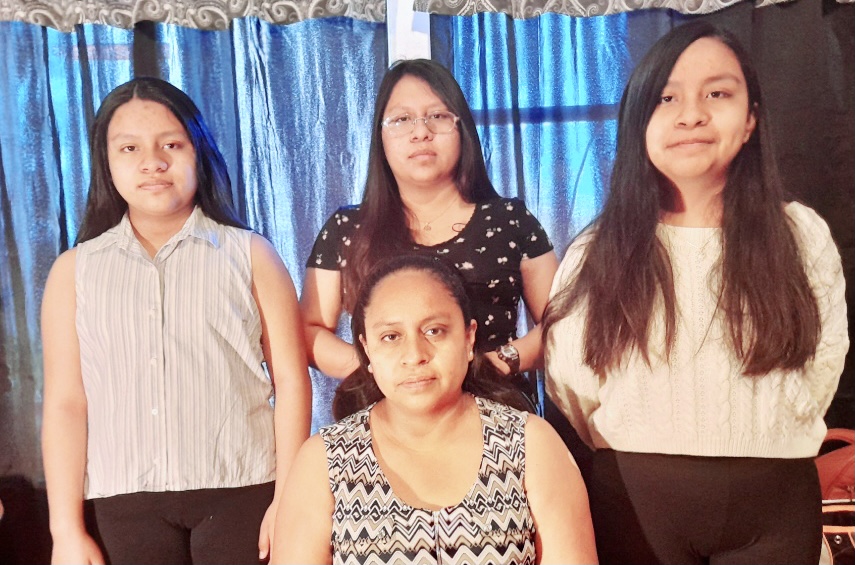Report: Learning Loss Data Shows 40,000 Los Angeles High School Students Off Track to Graduate

Forty thousand high school students in the Los Angeles Unified School District are at risk of not graduating — including 6,000 this year — according to a new analysis that tracks the effects of school closures on students in the nation’s second largest district.
In middle school, about a third of students in the district are currently on grade level in reading and math. Some of the worst learning loss was found in the early grades, where reading skills declined the most in kindergarten and first grade compared to the 2019-20 school year.
With the district preparing to reopen in two weeks, the report, from advocacy group Great Public Schools Now, shows engagement in remote classes has sharply increased since the beginning of the pandemic. But even with that improvement, more than a third of middle and high school students weren’t actively participating in online work last fall, the report found.

“I am hopeful about the reopening of Los Angeles schools, but we cannot simply pick up where we left off. Reopening alone does not address the recovery needed,” Ana Ponce, the executive director of the organization, wrote in the introduction to the report. Ponce previously served as CEO of Camino Nuevo Charter Academy in Los Angeles.
Whether students are passing their classes this year has become “a very important measure for understanding the impact of distance learning on students,” the report said. That’s because even though the district administered standardized assessments, participation rates were so low the data is inconclusive.
Grades in middle and high school have dropped most among Black and Hispanic students, who make up over 80 percent of the district’s almost 600,000 students. And only 2 percent of English learners and 9 percent of students with disabilities are on grade level in reading at those grades, according to student performance data presented to the Los Angeles school board.
Elmer Roldan, executive director of Communities In Schools of Los Angeles — a nonprofit that provides support to low-income students — said the district has delayed giving F’s, extended some tutoring options and is planning a summer school program.
“These steps have given current juniors and seniors some breathing room, especially the grade extensions,” he said. “Still, the learning loss is of real concern and we anticipate that students may find it hard to catch up.”
The district will begin to implement a hybrid plan for elementary schools in two weeks. Middle and high school students will return at the end of the month.
To Petronila Paxtor, a mother of three daughters in the district, that’s not soon enough. While her fifth grader, Jackelin, and her 10th grader, Brenda, have had relatively good interactions with their teachers through remote learning, the same isn’t true for eighth grader, Ana.
After schools closed last March, Ana had no live instruction until this past winter, Paxtor said, and even now, “sometimes the teachers don’t enter, don’t show up” on Zoom, she said. Having only reached the third grade in Guatemala, Paxtor said she feels unable to help with her daughters’ schoolwork. She searched for videos to help Ana and found a free tutoring program at the Koreatown Youth and Community Center.
“What I really want is for the schools to have these supports and these tools,” she said.

‘Work side-by-side’
The authors offer a series of recommendations, including examining other districts’ learning recovery efforts, prioritizing live instruction for those still learning at home and building up partnerships with outside organizations.
They urge the district to consider additional efforts to ensure more students have reliable broadband access. They mentioned the Chicago Connected initiative, which aims to provide internet access to 100,000 students by the end of the school year.
Partnership for Los Angeles Schools, a nonprofit working in 19 schools in the district, surveyed 1,100 families last summer and found that 30 percent had purchased either a device or internet service to keep their children connected.
Earlier this month, the district’s school board approved a resolution directing Superintendent Austin Beutner to find out how many students and educators are still having connection problems at home and spend $5 million to address remaining obstacles.
Other challenges to increasing learning time for students involve the district’s negotiations with the teachers union last summer over the length of the teacher workday. Hoping not to “shortchange” students, court transcripts show, district negotiators asked for a full, eight-hour day, but the union was able to whittle it down to six, with just four hours and 45 minutes of actual instructional time.
Based on reviews of union agreements in five large districts in California, the report notes that Los Angeles Unified students have the least average number of daily live instructional minutes this year — 114 at the elementary level compared to 255 in Long Beach Unified, which had the most.
As schools reopen, expectations for student performance are likely to increase, which could make it even harder for students to keep up. Roldan said. But the report’s authors stress that accelerating learning to help students earn the grades and credits they need to graduate is an important part of the recovery.
Tanya Ortiz Franklin, a member of the school board, agrees.
“The concept and practices of acceleration rather than remediation are ones we can and must build together so that all students can be fully prepared for college, career and life,” she said.
Get stories like these delivered straight to your inbox. Sign up for The 74 Newsletter

;)

